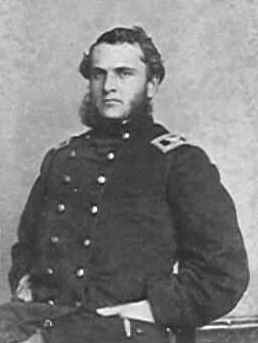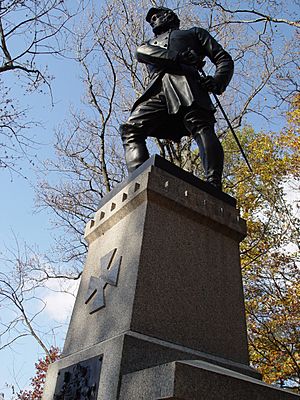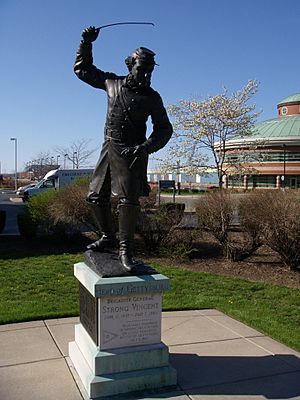Strong Vincent facts for kids
Quick facts for kids
Strong Vincent
|
|
|---|---|

Vincent as a colonel
|
|
| Born | June 17, 1837 Waterford, Pennsylvania |
| Died | July 7, 1863 (aged 26) Gettysburg, Pennsylvania |
| Buried |
Erie Cemetery, Erie, Pennsylvania
|
| Allegiance | United States of America |
| Service/ |
United States Army Union Army |
| Years of service | 1861–1863 |
| Rank | |
| Unit | Erie Regiment |
| Commands held | 83rd Pennsylvania Infantry 3rd Brigade, 1st Division, V Corps |
| Battles/wars | |
Strong Vincent (born June 17, 1837 – died July 7, 1863) was an American lawyer who became an important officer in the United States Army during the American Civil War. He is best known for his brave actions at the Battle of Gettysburg. He was badly wounded while leading his soldiers at a place called Little Round Top and died a few days later.
Early Life and Learning
Strong Vincent was born on June 17, 1837, in Waterford, Pennsylvania. His father, B. B. Vincent, owned an iron factory. Strong went to Trinity College and then to Harvard University, finishing his studies in 1859. After college, he became a lawyer in Erie, Pennsylvania.
Service in the Civil War
When the American Civil War began, Strong Vincent joined the Pennsylvania Militia. He started as a first lieutenant in the Erie Regiment. On September 14, 1861, he became a lieutenant colonel in the 83rd Pennsylvania Infantry. He was promoted to colonel in June of the next year.
After his commander died in a battle, Vincent took charge of his regiment. He later got sick with malaria and was on medical leave for a while. In May 1863, he was given command of the 3rd Brigade, which was part of the V Corps in the Army of the Potomac.
The Battle of Gettysburg
At the Battle of Gettysburg, 26-year-old Vincent and his brigade arrived on July 2, 1863. He knew his young wife, Elizabeth, was expecting their first child. He had written to her, "If I fall, remember you have given your husband to the most righteous cause that ever widowed a woman."

A Union general named Daniel Sickles had moved his soldiers, leaving a very important hill called Little Round Top unprotected. Another general, Gouverneur K. Warren, saw how important this hill was. He quickly looked for Union soldiers to defend it before the Confederate army could take it.
Warren's officer found Vincent's brigade nearby. Vincent decided on his own that his soldiers were in the perfect spot to defend Little Round Top. He said, "I will take the responsibility to take my brigade there." His bugler, Oliver Willcox Norton, later wrote that he and Vincent checked out the Confederate forces as the brigade moved into place.
One of Vincent's regiments, the 20th Maine, led by Colonel Joshua Chamberlain, became very famous for defending Little Round Top. However, Vincent's leadership and bravery were key to the Union victory there. Vincent told Colonel Chamberlain how important his position was on the left side of the brigade's line.
Then, Vincent went to check on the right side of his brigade. There, the 16th Michigan Infantry was starting to struggle against the enemy. Vincent stood on a large rock, holding a riding crop his wife had given him. He shouted to his men, "Don't give an inch!" A bullet hit him, and he fell.
Because of the determination of the 20th Maine, the 44th New York, the 140th New York Volunteer Infantry Regiment, the 83rd Pennsylvania, and the 16th Michigan Infantry, the Union line held strong against the Confederate attack. Vincent was carried off the hill to a nearby farm. He lay there for five days, too badly hurt to be moved home, and then he died.
The commander of the Army of the Potomac, General George Meade, recommended Vincent for a promotion to brigadier general on the evening of July 2. The promotion was officially dated July 3, 1863. It is not certain if Vincent knew about this honor before he passed away. Vincent's wife gave birth to a baby girl two months later, but the baby died before her first birthday and is buried next to her father.
Vincent's corps commander, General George Sykes, wrote about Vincent's actions in his official report:
Night closed the fight. The key of the battle-field was in our possession intact. Vincent, Weed, and Hazlett, chiefs lamented throughout the corps and army, sealed with their lives the spot intrusted to their keeping, and on which so much depended.... General Weed and Colonel Vincent, officers of rare promise, gave their lives to their country.
– George Sykes, report on the Battle of Gettysburg
Lasting Memory
Strong Vincent is buried in Erie Cemetery in Erie, Pennsylvania. There is a statue of him on the 83rd Pennsylvania monument at Little Round Top. Another statue was put up in 1997 at the Blasco Memorial Library in Erie. A school in Erie, the Strong Vincent Middle School, is also named after him.
The part of Little Round Top to the southeast of Sykes Avenue on the Gettysburg Battlefield is known as "Vincent's Spur." A unit of the Pennsylvania Army National Guard still uses the call sign "STRONG" to honor Vincent's courage and sacrifice.



